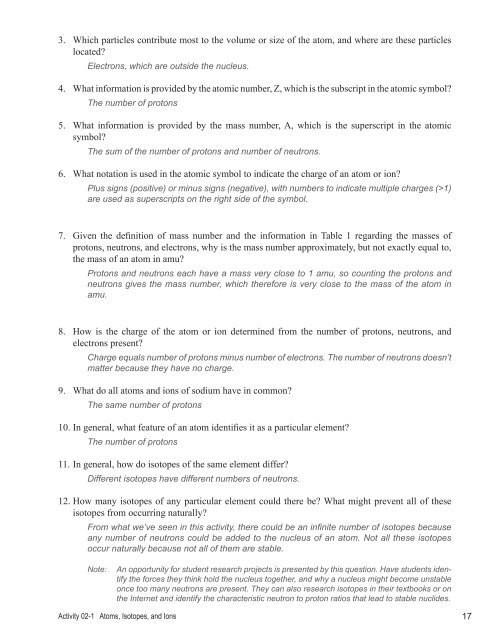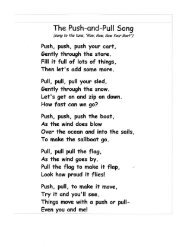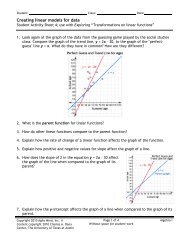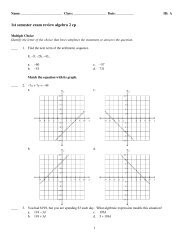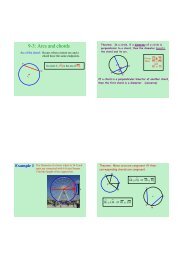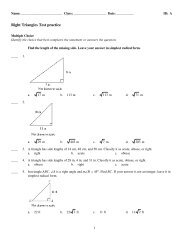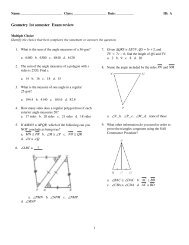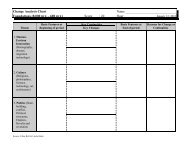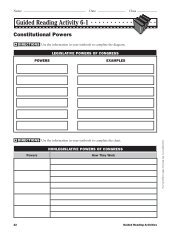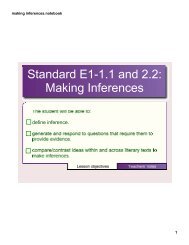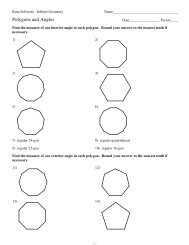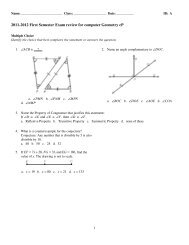You also want an ePaper? Increase the reach of your titles
YUMPU automatically turns print PDFs into web optimized ePapers that Google loves.
3. Which particles contribute most to the volume or size of the atom, <strong>and</strong> where are these particles<br />
located?<br />
Electrons, which are outside the nucleus.<br />
4. What information is provided by the atomic number, Z, which is the subscript in the atomic symbol?<br />
The number of protons<br />
5. What information is provided by the mass number, A, which is the superscript in the atomic<br />
symbol?<br />
The sum of the number of protons <strong>and</strong> number of neutrons.<br />
6. What notation is used in the atomic symbol to indicate the charge of an atom or ion?<br />
Plus signs (positive) or minus signs (negative), with numbers to indicate multiple charges (>1)<br />
are used as superscripts on the right side of the symbol.<br />
7. Given the definition of mass number <strong>and</strong> the information in Table 1 regarding the masses of<br />
protons, neutrons, <strong>and</strong> electrons, why is the mass number approximately, but not exactly equal to,<br />
the mass of an atom in amu?<br />
Protons <strong>and</strong> neutrons each have a mass very close to 1 amu, so counting the protons <strong>and</strong><br />
neutrons gives the mass number, which therefore is very close to the mass of the atom in<br />
amu.<br />
8. How is the charge of the atom or ion determined from the number of protons, neutrons, <strong>and</strong><br />
electrons present?<br />
Charge equals number of protons minus number of electrons. The number of neutrons doesn’t<br />
matter because they have no charge.<br />
9. What do all atoms <strong>and</strong> ions of sodium have in common?<br />
The same number of protons<br />
10. In general, what feature of an atom identifies it as a particular element?<br />
The number of protons<br />
11. In general, how do isotopes of the same element differ?<br />
Different isotopes have different numbers of neutrons.<br />
12. How many isotopes of any particular element could there be? What might prevent all of these<br />
isotopes from occurring naturally?<br />
From what we’ve seen in this activity, there could be an infi nite number of isotopes because<br />
any number of neutrons could be added to the nucleus of an atom. Not all these isotopes<br />
occur naturally because not all of them are stable.<br />
Note:<br />
An opportunity for student research projects is presented by this question. Have students identify<br />
the forces they think hold the nucleus together, <strong>and</strong> why a nucleus might become unstable<br />
once too many neutrons are present. They can also research isotopes in their textbooks or on<br />
the Internet <strong>and</strong> identify the characteristic neutron to proton ratios that lead to stable nuclides.<br />
Activity 02-1 <strong>Atoms</strong>, <strong>Isotopes</strong>, <strong>and</strong> <strong>Ions</strong> 17


